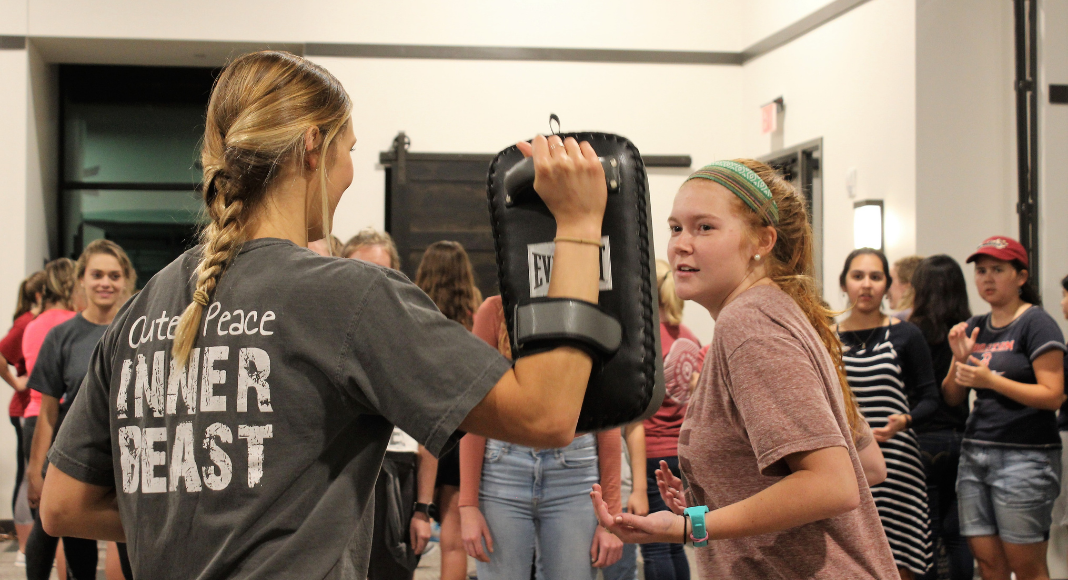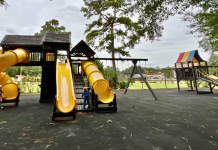*Thank you so much to Lauren Lamendola for this guest post and for contributing this important information.
Picture a room full of women sitting quietly with their eyes closed. “Raise your hand if you or someone you know has ever been a victim of sexual assault or domestic violence,” the
instructor says to the group. Every single hand goes up. As the women open their eyes and look around the room, you can feel the words “me too” silently being exchanged from eye to eye.
Just how common are domestic violence, sexual assault, and physical abuse?
Statistics say 1 in 6 women have been sexually assaulted in the United States today. Also, according to statistics, 1 in 5 women are sexually assaulted in college and 1 in 3 women have experienced relationship abuse, violence, or stalking. Equally shocking is the truth that 80% of perpetrators of these crimes are someone we know, trust, or even love.
Now that we know the statistics, how do we prevent ourselves, friends, and loved ones from becoming one of them?
Learning to predict threats to your safety is one of the most powerful ways to prevent them. First, we all must understand that perpetrators of these crimes are responsible for their actions. Nothing we do, wear, drink, or say gives anyone the right to hurt us nor does it place any responsibility upon us for their decisions. That being said, we must recognize that our bodies are able to detect both favorable and unfavorable scenarios to escape danger.
Self-defense is a mindset.
 We use it every second of every day and it is just as much mental as it is physical. At SASS (Surviving Assault Standing Strong) Go, we not only train women physically but mentally. SASS Go is a nonprofit organization on a mission to eradicate violence, abuse, and trafficking against women and girls globally. We offer prevention education, crisis response consulting, and self-defense training. Our team strongly believes in the strength and innate power inside of each woman. We offer hands-on, lifesaving training to all girls and women starting at the age of six. While physical skills are necessary, mental skills are just as important.
We use it every second of every day and it is just as much mental as it is physical. At SASS (Surviving Assault Standing Strong) Go, we not only train women physically but mentally. SASS Go is a nonprofit organization on a mission to eradicate violence, abuse, and trafficking against women and girls globally. We offer prevention education, crisis response consulting, and self-defense training. Our team strongly believes in the strength and innate power inside of each woman. We offer hands-on, lifesaving training to all girls and women starting at the age of six. While physical skills are necessary, mental skills are just as important.
Here are 5 critical skills you can use every day to save your life:
Critical Skill #1:
Trust Your Instincts
Instincts are natural innate responses, attitudes, and emotions regarding a stimulus in our environment. As humans, we have the ability to detect threats in our everyday lives. Detecting them feels like chills on the back of your neck, arm hairs standing up, a small voice repeating the same directive over and over, a memory you can’t ignore, or even a “head tilt” moment as someone shares a statement that just does not sit well. As humans, we also have judgment, denial, and logic which can be the weapons that stop us from trusting our instincts. We reason with ourselves, often talking ourselves out of trusting those instincts that are telling us something is not right. If your gut is telling you not to get on the elevator, that the car parked outside your house is out of place, or that someone is following you in the grocery store, do not talk yourself out of it, listen to your instincts. 
Critical Skill #2:
Plan Ahead
Planning ahead helps buy critical time in a life-threatening or emergency situation. Part of planning ahead involves a favorable vs. unfavorable mindset. With every situation, you walk into, think to yourself, “Is this favorable or unfavorable to my safety and well-being?” If unfavorable, leave. If you cannot leave, look for ways to make it more favorable. Here are a couple of common situations that may turn unfavorable and how to plan ahead:
- Going for a run – Research your route beforehand, run during daytime hours or
within an area that is brightly lit, take a friend or a dog with you, have an active GPS
on you (phone, apple watch, etc.) that can notify someone of your intended route so
they can check in on you, be aware of your surroundings by listening and looking
around, avoid headphones or use only one. - In the classroom/office – Sit as close to the door or window as possible, know your
exits and how you will use them to run from danger, have a plan that has actually
been practiced ensuring it would work to blockade the door or window if unable to
escape. - On a date/on the town – Share your plans and location with a friend, stay in public
locations, have an “out” or “code word” with a friend if the date becomes
uncomfortable, watch your drinks and alert someone immediately if your hands or
feet start to feel heavy and tingly, if your speech begins to slur, or if you feel outside
of your baseline behavior for the number of drinks you’ve had. - Looking for a new apartment/house – Do your homework on the area’s crime rates, install motion detectors, lights, cameras, how long does it take first responders to
get to your location, etc. Studies show the #1 deterrent of crime is anything that
suggests the perpetrator will be caught. - Uber – Verify the person and license plate, take a picture of both, and text it to a
friend or use the Uber app to share your status, sit behind the driver, check to make
sure you can unlock and open the doors, ask the Uber driver how long the ride will
take and let them know you have a friend or family member tracking you. If they
deviate from the way you should be heading say something and call 911 if they will
not listen.
Critical Skill #3:
Know the signs of a predator
Strangers are not always our biggest threats. Over 80% of perpetrators of assault and abuse are someone we know, trust, or love. While most women dream of their very own Prince Charming, be on the lookout for too much “charm”. Charm is not something people are born with; it is a learned behavior used to get what one wants. If you question whether or not the motive is altruistic, listen to that intuition and trust your gut. Unsolicited promises are another way to spot a predator. Think of these as an “if-then” situation. “If you give me a ride to my car, I promise I will leave you alone.” “If you let me come in for a glass of water, I promise I’ll leave after that.” “If you give me one kiss, I promise I won’t ask for anything else.” Be on high alert, as these scenarios often predict extremely dangerous situations in which the promisor is so desperate to get what they want, they are willing to say whatever it takes to get you to comply, even if it is a lie.
Critical Skill #4:
Awareness Always
As previously expressed, self-defense is a mindset. This means it is always on, activated, and alert. Always be aware of what is going on around you, even when in your home. Here are a few ways to stay aware while still engaging in your daily activities:
• While at home – Always lock your doors, install cameras, motion-detecting lights,
and have a safe place or a plan of action if someone were to breach your perimeter.
• While in Your Car – Never sit alone in your car, park near lights, back into the parking spaces for the quickest escape, have someone walk you to your car if you feel
unsafe, and always leave a gap between you and the car beside you.
• While Out on the Town – If threatened, do not wait for help to arrive, run/get away
and call 911 as soon as you safely can, travel in packs, if asked for your belongings
give them everything but you, never get in a car or go to the second location, as statistically, you are unlikely to come back.
Critical Skill #5:
Use your Resources
Voices are powerful and can be used to stop a potential threat, uncover skills, or find the
support survivors need. Here are a few ways you can use your voice and some resources to help survivors find their voices again.
- Saying NO– When you say no, it is not the beginning of a debate. No is a full sentence. If someone refuses to hear your no, instead of thinking “Is there something wrong with me,” ask “What is wrong with them” and get to safety immediately.
- SASS Go –Use your voice and train both physically and mentally for the most common threats to safety. (803) 317-7277
- RAINN National Network – National Sexual Assault Hotline (800) 656-4673
- National Domestic Violence Hotline– (800) 799-7233
- National Human Trafficking Hotline – (888) 373-7888
- Pathways to Safety International – Interpersonal Violence Abroad (833) 723-3833
About the Author
 Lauren Lamandola is a Women’s Self-Defense instructor in Charleston, SC. She has been teaching women’s self-defense for four years and is passionate about empowering women and girls of all ages. Lauren, along with the entire team at SASS Go, is on a mission to eradicate sexual assault and domestic violence. When she is not teaching, Lauren works as an Orthopedic Physician Assistant at Southern Orthopedics and Sports Medicine.
Lauren Lamandola is a Women’s Self-Defense instructor in Charleston, SC. She has been teaching women’s self-defense for four years and is passionate about empowering women and girls of all ages. Lauren, along with the entire team at SASS Go, is on a mission to eradicate sexual assault and domestic violence. When she is not teaching, Lauren works as an Orthopedic Physician Assistant at Southern Orthopedics and Sports Medicine.













